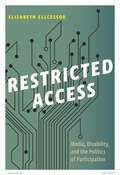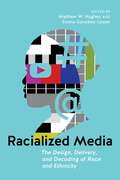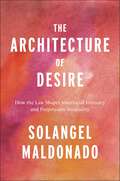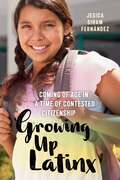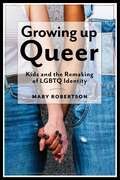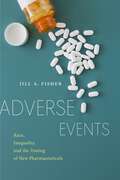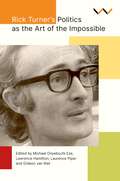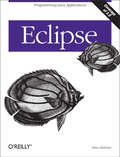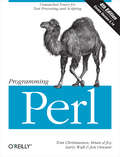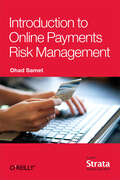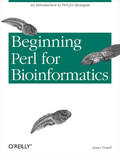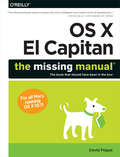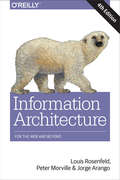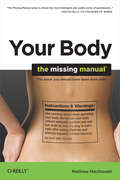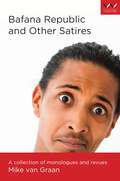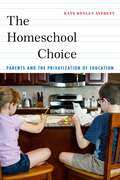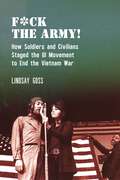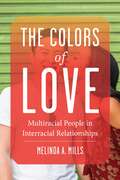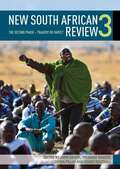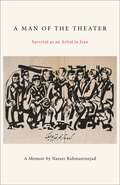- Table View
- List View
Restricted Access: Media, Disability, and the Politics of Participation (Postmillennial Pop #6)
by Elizabeth EllcessorHow reconsidering digital media and participatory cultures from the standpoint of disability allows for a full understanding of accessibility. While digital media can offer many opportunities for civic and cultural participation, this technology is not equally easy for everyone to use. Hardware, software, and cultural expectations combine to make some technologies an easier fit for some bodies than for others. A YouTube video without closed captions or a social network site that is incompatible with a screen reader can restrict the access of users who are hard of hearing or visually impaired. Often, people with disabilities require accommodation, assistive technologies, or other forms of aid to make digital media accessible—useable—for them.Restricted Access investigates digital media accessibility—the processes by which media is made usable by people with particular needs—and argues for the necessity of conceptualizing access in a way that will enable greater participation in all forms of mediated culture. Drawing on disability and cultural studies, Elizabeth Ellcessor uses an interrogatory framework based around issues of regulation, use, content, form, and experience to examine contemporary digital media. Through interviews with policy makers and accessibility professionals, popular culture and archival materials, and an ethnographic study of internet use by people with disabilities, Ellcessor reveals the assumptions that undergird contemporary technologies and participatory cultures. Restricted Access makes the crucial point that if digital media open up opportunities for individuals to create and participate, but that technology only facilitates the participation of those who are already privileged, then its progressive potential remains unrealized. Engagingly written with powerful examples, Ellcessor demonstrates the importance of alternate uses, marginalized voices, and invisible innovations in the context of disability identities to push us to rethink digital media accessibility.
Racialized Media: The Design, Delivery, and Decoding of Race and Ethnicity (Goldstein-Goren American Jewish History)
by Matthew W. Hughey and Emma González-LesserHow media propagates and challenges racismFrom Black Panther to #OscarsSoWhite, the concept of “race,” and how it is represented in media, has continued to attract attention in the public eye. In Racialized Media, Matthew W. Hughey, Emma González-Lesser, and the contributors to this important new collection of original essays provide a blueprint to this new, ever-changing media landscape.With sweeping breadth, contributors examine a number of different mediums, including film, television, books, newspapers, social media, video games, and comics. Each chapter explores the impact of contemporary media on racial politics, culture, and meaning in society. Focusing on producers, gatekeepers, and consumers of media, this book offers an inside look at our media-saturated world, and the impact it has on our understanding of race, ethnicity, and more. Through an interdisciplinary lens, Racialized Media provides a much-needed look at the role of race and ethnicity in all phases of media production, distribution, and reception.
The Architecture of Desire: How the Law Shapes Interracial Intimacy and Perpetuates Inequality (Families, Law, and Society #26)
by Solangel MaldonadoExplores the reach of the law into our most personal and private romantic livesThe Architecture of Desire examines how the law influences our most personal and private choices—who we desire and choose as intimate partners—and explores the psychological, economic, and social effects of these choices. Romantic preferences, as shaped by law, perpetuate segregation and subordination by limiting, on the basis of race, individuals’ prospects for marriage and marriage-like commitments, as well as economic and social mobility.The book begins by tracing the legacy of slavery, anti-miscegenation, segregation, and racially discriminatory immigration laws to show how this legal landscape facilitated the residential, economic, and social distance between racial and ethnic groups, which in turn continue to shape romantic preferences today. Solangel Maldonado argues that the law further influences intimate choices by structuring the spaces within which individuals meet and interact via practices such as redlining, gentrification, and zoning.Maldonado includes studies of online and offline dating preferences to demonstrate that romantic predilections follow a gendered racial hierarchy in which Whites are at the top, African-Americans at the bottom, and—depending on skin tone—Asian-Americans and Latinos in the middle. These preferences may be explicit, implicit, or both, but they are usually the result of stereotypes reflected in social and cultural norms. Furthermore, since marriage confers substantial legal, economic, and social advantages, sexual racism further limits an individual’s opportunity to find a partner and reap these benefits. Finally, the book proposes ways to minimize the law’s influence over who we desire, love, and bring into our families, such as changes to dating platforms as well as to housing, education, and transportation policies.
Growing Up Latinx: Coming of Age in a Time of Contested Citizenship (Critical Perspectives on Youth)
by Jesica Siham FernándezWinner, Outstanding Scholarly Contribution Award of the Section on Children and Youth, given by the American Sociological AssociationFinalist for the 2021 C. Wright Mills Award, given by the Society for the Study of Social ProblemsLatinx children navigating identity, citizenship, and belonging in a divided America An estimated sixty million people in the United States are of Latinx descent, with youth under the age of eighteen making up two-thirds of this swiftly growing demographic. In Growing Up Latinx, Jesica Siham Fernández explores the lives of Latinx youth as they grapple with their social and political identities from an early age, and pursue a sense of belonging in their schools and communities as they face an increasingly hostile political climate.Drawing on interviews with nine-to-twelve-year-olds, Fernández gives us rare insight into how Latinx youth understand their own citizenship and bravely forge opportunities to be seen, to be heard, and to belong. With a compassionate eye, she shows us how they strive to identify, and ultimately redefine, what it means to come of age—and fight for their rights—in a country that does not always recognize them. Fernández follows Latinx youth as they navigate family, school, community, and country ties, richly detailing their hopes and dreams as they begin to advocate for their right to be treated as citizens in full. Growing Up Latinx invites us to witness the inspiring power of young people as they develop and make heard their political voices, broadening our understanding of citizenship.
Growing Up Queer: Kids and the Remaking of LGBTQ Identity (Critical Perspectives on Youth #3)
by Mary RobertsonLGBTQ kids reveal what it’s like to be young and queer today Growing Up Queer explores the changing ways that young people are now becoming LGBT-identified in the US. Through interviews and three years of ethnographic research at an LGBTQ youth drop-in center, Mary Robertson focuses on the voices and stories of youths themselves in order to show how young people understand their sexual and gender identities, their interest in queer media, and the role that family plays in their lives. The young people who participated in this research are among the first generation to embrace queer identities as children and adolescents. This groundbreaking and timely consideration of queer identity demonstrates how sexual and gender identities are formed through complicated, ambivalent processes as opposed to being natural characteristics that one is born with. In addition to showing how youth understand their identities, Growing Up Queer describes how young people navigate queerness within a culture where being gay is the “new normal.” Using Sara Ahmed’s concept of queer orientation, Robertson argues that being queer is not just about one’s sexual and/or gender identity, but is understood through intersecting identities including race, class, ability, and more. By showing how society accepts some kinds of LGBTQ-identified people while rejecting others, Growing Up Queer provides evidence of queerness as a site of social inequality. The book moves beyond an oversimplified examination of teenage sexuality and shows, through the voices of young people themselves, the exciting yet complicated terrain of queer adolescence.
Adverse Events: Race, Inequality, and the Testing of New Pharmaceuticals (Anthropologies of American Medicine: Culture, Power, and Practice #9)
by Jill A. FisherWinner, 2022 Donald W. Light Award for Applied Medical Sociology, given by the Medical Sociology Section of the American Sociological AssociationWinner, 2021 Robert K. Merton Book Award, given by the Science, Knowledge, and Technology Section of the American Sociological Association2021 Outstanding Academic Title, Choice MagazineExplores the social inequality of clinical drug testing and its effects on scientific resultsImagine that you volunteer for the clinical trial of an experimental drug. The only direct benefit of participating is that you will receive up to $5,175. You must spend twenty nights literally locked in a research facility. You will be told what to eat, when to eat, and when to sleep. You will share a bedroom with several strangers. Who are you, and why would you choose to take part in this kind of study? This book explores the hidden world of pharmaceutical testing on healthy volunteers. Drawing on two years of fieldwork in clinics across the country and 268 interviews with participants and staff, it illustrates how decisions to take part in such studies are often influenced by poverty and lack of employment opportunities. It shows that healthy participants are typically recruited from African American and Latino/a communities, and that they are often serial participants, who obtain a significant portion of their income from these trials. This book reveals not only how social inequality fundamentally shapes these drug trials, but it also depicts the important validity concerns inherent in this mode of testing new pharmaceuticals. These highly controlled studies bear little resemblance to real-world conditions, and everyone involved is incentivized to game the system, ultimately making new drugs appear safer than they really are. Adverse Events provides an unprecedented view of the intersection of racial inequalities with pharmaceutical testing, signaling the dangers of this research enterprise to both social justice and public health.
Rick Turner's Politics as the Art of the Impossible
by Crain Soudien Ayesha Omar Billy Keniston Michael Onyebuchi Eze Lawrence Hamilton Laurence Piper Gideon van Riet Paula Ensor Daryl Glaser Christine Hobden John Sodiq Sanni Tendayi SitholeRevisits the work of Rick Turner, a South African political theorist, and addresses contemporary debatesRick Turner was a South African academic and anti-apartheid activist who rebelled against the apartheid state at the height of its power. For this he was assassinated in 1978, at just 32 years of age, but his life and work are testimony to the power of philosophical thinking for humans everywhere. Turner chose to live freely in an unfree time and argued for a non-racial, socialist future in a context where this seemed unimaginable.This book takes seriously Rick Turner’s challenge that political theorising requires thinking in a utopian way. Turner’s seminal book The Eye of the Need: Towards a Participatory Democracy laid out some of his most potent ideas on a radically different political and economic system. His demand was that we work to escape the limiting ideas of the present, carefully design a just future based on shared human values, and act to make it a reality, both politically and in our daily lives.The contributors to this volume engage critically with Turner’s work on race relations, his relationship with Steve Biko, his views on religion, education and gender oppression, his participatory model of democracy, and his critique of enduring forms of poverty and economic inequality. They show how, in his life and work, Turner modeled how we can dare to be free and how hope can return, as the future always remains open to human construction. This book makes an important contribution to contemporary thinking and activism where the need for South Africans to define their understanding of their greater common good is of crucial importance.
WITS: A University in the Apartheid Era
by Mervyn ShearWhen the National Government assumed power in 1948, one of the earliest moves was to introduce segregated education. Its threats to restrict the admission of black students into the four ‘open universities’ galvanised the staff and students of those institutions to oppose any attempt to interfere with their autonomy and freedom to decide who should be admitted. In subsequent years, as the regime adopted increasingly oppressive measures to prop up the apartheid state, opposition on the campuses, and in the country, increased and burgeoned into a Mass Democratic Movement intent on making the country ungovernable. Protest escalated through successive states of emergency and clashes with police on campus became regular events. Residences were raided, student leaders were harassed by security police and many students and some staff were detained for lengthy periods without recourse to the courts. First published in 1996, WITS: A University in the Apartheid Era by Mervyn Shear tells the story of how the University of the Witwatersrand (Wits) adapted to the political and social developments in South Africa under apartheid. This new edition is published in the University’s centenary year with a preface by Firoz Cachalia, one of Wits’ student leaders in the 1980s. It serves as an invaluable historical resource on questions about the relationship between the University and the state, and on understanding the University’s place and identity in a constitutional democracy.
Eclipse: Programming Java Applications
by Steve HolznerJava programmers know how finicky Java can be to work with. An omitted semi-colon or the slightest typo will cause the Java command-line compiler to spew pages of annoying error messages across your screen. And it doesn't fix them--that's up to you: fix them, compile again, and hope that nothing goes wrong this time.Eclipse, the popular Java integrated development environment (IDE) provides an elegant and powerful remedy for this common, frustrating scenario. It doesn't just catch your errors before you compile, it also suggests solutions. All you need to do is point and click. And it's free--what could be better? Still, if you're like most programmers, mastering a new technology--no matter how productive it will make you in the long run--is going to take a chunk out of your productivity now. You want to get up to speed quickly without sacrificing efficiency.O'Reilly's new guide to the technology, Eclipse, provides exactly what you're looking for: a fast-track approach to mastery of Eclipse. This insightful, hands-on book delivers clear and concise coverage, with no fluff, that gets down to business immediately. The book is tightly focused, covering all aspects of Eclipse: the menus, preferences, views, perspectives, editors, team and debugging techniques, and how they're used every day by thousands of developers. Development of practical skills is emphasized with dozens of examples presented throughout the book.From cover-to-cover, the book is pure Eclipse, covering hundreds of techniques beginning with the most basic Java development through creating your own plug-in editors for the Eclipse environment. Some of the topics you'll learn about include:Using Eclipse to develop Java codeTesting and debuggingWorking in teams using CVSBuilding Eclipse projects using AntThe Standard Widget Toolkit (SWT)Web developmentDeveloping Struts applications with EclipseFrom basics to advanced topics, Eclipse takes you through the fundamentals of Eclipse and more. You may be an Eclipse novice when you pick up the book, but you'll be a pro by the time you've finished.
Programming Perl: Unmatched power for text processing and scripting
by Tom Christiansen Jon Orwant Larry Wall Brian D FoyAdopted as the undisputed Perl bible soon after the first edition appeared in 1991, Programming Perl is still the go-to guide for this highly practical language. Perl began life as a super-fueled text processing utility, but quickly evolved into a general purpose programming language that’s helped hundreds of thousands of programmers, system administrators, and enthusiasts, like you, get your job done.In this much-anticipated update to "the Camel," three renowned Perl authors cover the language up to its current version, Perl 5.14, with a preview of features in the upcoming 5.16. In a world where Unicode is increasingly essential for text processing, Perl offers the best and least painful support of any major language, smoothly integrating Unicode everywhere—including in Perl’s most popular feature: regular expressions.Important features covered by this update include:New keywords and syntaxI/O layers and encodingsNew backslash escapesUnicode 6.0Unicode grapheme clusters and propertiesNamed captures in regexesRecursive and grammatical patternsExpanded coverage of CPANCurrent best practices
Introduction to Online Payments Risk Management
by Ohad SametIf you've been tasked with building a team to handle risk management for online payments (RMP), this practical introduction provides a framework for choosing the technologies and personnel you need. Author and financial services executive Ohad Samet explains the components of payments risk management, and presents a coherent strategy and operational approach.You'll learn the answers to questions you're likely to encounter in the first 18 months of operation, with information that Samet has shaped and tested over several years in the industry. This book is ideal whether you intend to be a one-person task force or work with dozens of agents and analysts.Use both a portfolio and behavioral approach to analyzing and optimizing lossesLearn about your customers to determine if they can and will meet obligationsBuild an RMP team for payment risk operations, analytics, and decision automationUse linking mechanisms and velocity models to detect unusual activity among your customersDesign system and data architecture to facilitate your activity analysisImplement the decision and loss-reduction mechanisms you need to act on your findings
Beginning Perl for Bioinformatics: An Introduction to Perl for Biologists
by James TisdallWith its highly developed capacity to detect patterns in data, Perl has become one of the most popular languages for biological data analysis. But if you're a biologist with little or no programming experience, starting out in Perl can be a challenge. Many biologists have a difficult time learning how to apply the language to bioinformatics. The most popular Perl programming books are often too theoretical and too focused on computer science for a non-programming biologist who needs to solve very specific problems.Beginning Perl for Bioinformatics is designed to get you quickly over the Perl language barrier by approaching programming as an important new laboratory skill, revealing Perl programs and techniques that are immediately useful in the lab. Each chapter focuses on solving a particular bioinformatics problem or class of problems, starting with the simplest and increasing in complexity as the book progresses. Each chapter includes programming exercises and teaches bioinformatics by showing and modifying programs that deal with various kinds of practical biological problems. By the end of the book you'll have a solid understanding of Perl basics, a collection of programs for such tasks as parsing BLAST and GenBank, and the skills to take on more advanced bioinformatics programming. Some of the later chapters focus in greater detail on specific bioinformatics topics. This book is suitable for use as a classroom textbook, for self-study, and as a reference.The book covers:Programming basics and working with DNA sequences and strings Debugging your codeSimulating gene mutations using random number generatorsRegular expressions and finding motifs in dataArrays, hashes, and relational databasesRegular expressions and restriction mapsUsing Perl to parse PDB records, annotations in GenBank, and BLAST output
Python Pocket Reference: Python In Your Pocket (Pocket Reference (o'reilly) Ser.)
by Mark LutzUpdated for both Python 3.4 and 2.7, this convenient pocket guide is the perfect on-the-job quick reference. Youâ??ll find concise, need-to-know information on Python types and statements, special method names, built-in functions and exceptions, commonly used standard library modules, and other prominent Python tools. The handy index lets you pinpoint exactly what you need.Written by Mark Lutzâ??widely recognized as the worldâ??s leading Python trainerâ??Python Pocket Reference is an ideal companion to Oâ??Reillyâ??s classic Python tutorials, Learning Python and Programming Python, also written by Mark.This fifth edition covers:Built-in object types, including numbers, lists, dictionaries, and moreStatements and syntax for creating and processing objectsFunctions and modules for structuring and reusing codePythonâ??s object-oriented programming toolsBuilt-in functions, exceptions, and attributesSpecial operator overloading methodsWidely used standard library modules and extensionsCommand-line options and development toolsPython idioms and hintsThe Python SQL Database API
OS X El Capitan: The Missing Manual
by David PogueWith El Capitan, Apple brings never-before-seen features to OS X—like a split-screen desktop, improved window controls, and amazing graphics. The new edition of David Pogue's #1 bestselling Mac book shows you how to use key new features such as swiping gestures, Notes, a new Spotlight search system, the Safari pinning feature, and Split View.Missing Manuals creator David Pogue is one of the most widely recognized technology authors in the world. A former New York Times technology columnist, he founded and now produces videos for Yahoo Tech.
Getting Started with Impala: Interactive SQL for Apache Hadoop
by John RussellLearn how to write, tune, and port SQL queries and other statements for a Big Data environment, using Impala—the massively parallel processing SQL query engine for Apache Hadoop. The best practices in this practical guide help you design database schemas that not only interoperate with other Hadoop components, and are convenient for administers to manage and monitor, but also accommodate future expansion in data size and evolution of software capabilities.Written by John Russell, documentation lead for the Cloudera Impala project, this book gets you working with the most recent Impala releases quickly. Ideal for database developers and business analysts, the latest revision covers analytics functions, complex types, incremental statistics, subqueries, and submission to the Apache incubator.Getting Started with Impala includes advice from Cloudera’s development team, as well as insights from its consulting engagements with customers.Learn how Impala integrates with a wide range of Hadoop componentsAttain high performance and scalability for huge data sets on production clustersExplore common developer tasks, such as porting code to Impala and optimizing performanceUse tutorials for working with billion-row tables, date- and time-based values, and other techniquesLearn how to transition from rigid schemas to a flexible model that evolves as needs changeTake a deep dive into joins and the roles of statistics
Information Architecture: For the Web and Beyond
by Peter Morville Louis Rosenfeld Jorge ArangoInformation architecture (IA) is far more challenging—and necessary—than ever. With the glut of information available today, anything your organization wants to share should be easy to find, navigate, and understand. But the experience you provide has to be familiar and coherent across multiple interaction channels, from the Web to smartphones, smartwatches, and beyond.To guide you through this broad ecosystem, this popular guide—now in its fourth edition—provides essential concepts, methods, and techniques for digital design that have withstood the test of time. UX designers, product managers, developers, and anyone involved in digital design will learn how to create semantic structures that will help people engage with your message.This book includes:An overview of IA and the problems it solves for creating effective digital products and servicesA deep dive into IA components, including organization, labeling, navigation, search, and metadataProcesses and methods that take you from research to strategy, design, and IA implementation
Using the HTML5 Filesystem API: A True Filesystem for the Browser
by Eric BidelmanSeveral client-side storage options are available to web applications, but one area that's been lacking until now is file I/O—the ability to organize binary data into a true hierarchy of folders. That has changed with the advent of HTML5. With this book, you'll learn how to provide your applications with a file system that enables them to create, read, and write files and folders in a sandboxed section of the user's local filesystem.Author Eric Bidelman, a Senior Developer Programs Engineer on the Google Chrome team, provides several techniques and complete code examples for working with the HTML5 Filesystem API.Learn common operations for working with files and directoriesBecome familiar with HTML5's storage use cases and security considerationsUnderstand the storage options available, including temporary, persistent, and unlimitedWrite text or append data to an existing user fileImport files into your application by accessing a user's hard driveGet techniques for using a file with filesystem, blob, or data URLsUse the synchronous version of the HTML5 Filesystem API within a Web Worker context
Your Body: The Missing Manual
by Matthew MacDonaldWhat, exactly, do you know about your body? Do you know how your immune system works? Or what your pancreas does? Or the myriad -- and often simple -- ways you can improve the way your body functions?This full-color, visually rich guide answers these questions and more. Matthew MacDonald, noted author of Your Brain: The Missing Manual, takes you on a fascinating tour of your body from the outside in, beginning with your skin and progressing to your vital organs. You'll look at the quirks, curiosities, and shortcomings we've all learned to live with, and pick up just enough biology to understand how your body works. You'll learn:That you shed skin more frequently than snakes doWhy the number of fat cells you have rarely changes, no matter how much you diet or exercise -- they simply get bigger or smallerHow you can measure and control fatThat your hair is made from the same stuff as horses' hoovesThat you use only a small amount of the oxygen you inhaleWhy blood pressure is a more important health measure than heart rate -- with four ways to lower dangerously high blood pressureWhy our bodies crave foods that make us fatHow to use heart rate to shape an optimal workout session -- one that's neither too easy nor too strenuousWhy a tongue with just half a dozen taste buds can identify thousands of flavorsWhy bacteria in your gut outnumbers cells in your body -- and what function they serveWhy we age, and why we can't turn back the clockWhat happens to your body in the minutes after you dieRather than dumbed-down self-help or dense medical text, Your Body: The Missing Manual is entertaining and packed with information you can use. It's a book that may well change your life.Reader comments for Your Brain: The Missing Manual, also by author Matthew MacDonald:"Popular books on the brain are often minefields of attractive but inaccurate information. This one manages to avoid most of the hype and easy faulty generalizations while providing easy to read and digest information about the brain. It has useful tricks without the breathless hype of many popular books."-- Elizabeth Zwicky, The Usenix Magazine "...a unique guide that should be sought after by any who want to maximize what they can accomplish with their mental abilities and resources."-- James A. Cox, The Midwest Book Review - Wisconsin Bookwatch "If you can't figure out how to use your brain after reading this guide, you may want to return your brain for another."-- The Sacramento Book Review, Volume 1, Issue 2, Page 19 "It's rare to find a book on any technical subject that is as well written and readable as Your Brain: The Missing Manual. The book covers pretty much anything you may want to know about your brain, from what makes it up, through how it develops to how to mitigate the affects of aging. The book is easy reading, fact packed and highlighted notes and practical applications. So if you want to learn more about your brain, how it works, how to get the best out of it or just want to stave off the ravages of Alzheimers (see chapter ten for details of how learning helps maintain your brain) then I can't recommend this book highly enough."-- Neil Davis, Amazon.co.uk "MacDonald's writing style is perfect for this kind of guide. It remains educational without becoming overly technical or using unexplained jargon. And even though the book covers a broad scope of topics, MacDonald keeps it well organized and easy to follow. The book captures your attention with fun facts and interesting studies that any person could apply to their own understanding of human ability. It has great descriptions of the brain and its interconnected parts, as well as providing full color pictures and diagrams to offer a better explanation of what the author is talking about."-- Janica Unruh, Blogcritics Magazine
Bafana Republic and Other Satires: A collection of monologues and revues
by Mike van GraanThis collection of satirical sketches takes readers on a sometimes cynical, sometimes hilarious trip through many of the issues that face democratic South AfricaThe seed of this collection was sown in 2007 when South Africa won the right to host the 2010 FIFA World Cup. The debate about huge amounts of public funds being spent on a 'vanity project' instead of being used to improve the lives of the majority of the country’s citizens inspired Mike van Graan, one of South Africa's leading contemporary political playwrights, to use sport as an entry point for satirical commentary. Van Graan follows this with piercing attention towards matters of the state. With themes ranging from the World Cup to the political football of land, from the violent abuse of women to state capture, this selection of satirical sketches takes readers on a rollercoaster trip through many of the issues that face democratic South Africa. The sketches come from six one-person revues, Bafana Republic (2007), Bafana Republic: Extra Time (2008), Bafana Republic: Penalty Shootout (2009), Pay Back the Curry (2016), State Fracture (2017) and Land Acts (2018). Van Graan uses a potent mix of comedy, poetry and drama to make points that hit hard at core issues which 21st-century South Africans are struggling with. Readers will laugh and cringe and sometimes cry, but one thing they will not be able to do is remain unaffected.
The Homeschool Choice: Parents and the Privatization of Education (Critical Perspectives on Youth)
by Kate Henley AverettHonorable Mention, Sex & Gender Section Distinguished Book Award, given by the American Sociological AssociationThe surprising reasons parents are opting out of the public school system and homeschooling their kidsHomeschooling has skyrocketed in popularity in the United States: in 2019, a record-breaking 2.5 million children were being homeschooled. In The Homeschool Choice, Kate Henley Averett provides insight into this fascinating phenomenon, exploring the perspectives of parents who have chosen to homeschool their children. Drawing on in-depth interviews, Averett examines the reasons why these parents choose to homeschool, from those who disagree with sex education and LGBT content in schools, to others who want to protect their children’s sexual and gender identities. With eye-opening detail, she shows us how homeschooling is a trend being chosen by an increasingly diverse subset of American families, at times in order to empower—or constrain—children’s gender and sexuality. Ultimately, Averett explores how homeschooling, as a growing practice, has changed the roles that families, schools, and the state play in children’s lives. As teachers, parents, and policymakers debate the future of public education, The Homeschool Choice sheds light on the ongoing struggle over school choice.
F*ck The Army!: How Soldiers and Civilians Staged the GI Movement to End the Vietnam War (Performance and American Cultures #7)
by Lindsay GossReveals the theatrical dimensions of civilian support for the revolutionary GI Movement of the 1960s-70sPerformance played a role both crucial and complicated in the antiwar activism of the 1960s and 1970s. As soldiers and civilian actors, activists, and celebrities worked together to end the Vietnam War, their theatrical acts of solidarity and resistance connected liberation struggles across the lines of race, gender, enlisted status, and nationality.F*ck The Army! offers the first, fully narrated history of the FTA, an antiwar variety show featuring Jane Fonda that played to tens of thousands of active-duty troops over the course of nine months in 1971. From its very conception, the civilian-led show was directed towards the project of making visible the growing antiwar movement organized by GIs, inspired by but also acting as a rebuttal to the increasingly out-of-touch USO tours presented by Bob Hope. Through an analysis of the FTA’s tactical performances of solidarity and resistance, Lindsay Goss brings into view the theatrical dimensions of the GI movement itself, revealing it as representative of the revolutionary and theatrical politics and tactics of the period. The volume highlights how, due to the movement’s subsequent historical erasure, a renewed anti-theatricality emerged from the 1960s and became a potent feature of contemporary political discourse.The author’s deft methodological and analytic strategies, in tandem with her elegantly accessible style demonstrate how seemingly little-known performance practices can activate consequential understandings of what we thought we knew about the recent past. At the same time, she encourages essential conversations about pressing contemporary issues that demand our attention. At its core, F*ck The Army! reveals the fundamentally theatrical character of radical activism when it seeks to challenge the status quo.
The Colors of Love: Multiracial People in Interracial Relationships
by Melinda A. MillsHow multiracial people navigate the complexities of race and love In the United States, more than seven million people claim to be multiracial, or have racially mixed heritage, parentage, or ancestry. In The Colors of Love, Melinda A. Mills explores how multiracial people navigate their complex—and often misunderstood—identities in romantic relationships.Drawing on sixty interviews with multiracial people in interracial relationships, Mills explores how people define and assert their racial identities both on their own and with their partners. She shows us how similarities and differences in identity, skin color, and racial composition shape how multiracial people choose, experience, and navigate love. Mills highlights the unexpected ways in which multiracial individuals choose to both support and subvert the borders of race as individuals and as romantic partners. The Colors of Love broadens our understanding about race and love in the twenty-first century.
New South African Review 3: The second phase – Tragedy or farce? (New South African Review Ser. #3)
by Prishani Naidoo Devan Pillay Roger Southall John DanielAn evaluation of the ANC's second phase of the national democratic revolution.In the face of the continuing national tragedy of the inequality, poverty and unemployment which have triggered rising working-class discontent around the country, the ANC announced a 'second phase' of the 'national democratic revolution' to deal with the challenges. Ironically, the ANC post-Mangaung has resolved to preserve the core tenets of the minerals-energy-financial complex that defined racial capitalism - while at the same time ratcheting up the revolutionary rhetoric to keep the working class and marginalised onside. If the 'first phase' was a tragedy of the unmet expectations of the majority, is the 'second phase' likely to be a farce? The chapters in this volume are written by experts in their fields and address issues of politics, power and social class; economy, ecology and labour; public policy and social practice; and South Africa beyond its borders. They examine some of these challenges, and indicate that they are as much about the defective content of policies as their poor implementation. The third volume of the New South African Review continues the series by providing in-depth analyses of the key issues facing the country today.
A Man of the Theater: Survival as an Artist in Iran
by Nasser RahmaninejadLife in Iran as an artist under the Shah and during the Iranian RevolutionA Man of the Theater tells the personal story of a theater artist caught between the two great upheavals of Iranian history in the 20th century. One is the White Revolution of the 1960s, the incomplete and uneven modernization imposed from the top by the dictatorial regime of the Shah, coming in the wake of the overthrow of the popular Mosaddegh government with the help of the CIA. The other one is the Iranian Revolution of 1979, a great rising of Iranian society against the rule of the Shah in which Khomeini’s Islamist faction ends up taking power. Written in a simple direct style, Rahmaninejad’s memoir describes his fraught creative life in Tehran during these decades, founding a theater company and directing plays under the increasing pressure of the censorship authorities and the Shah’s secret police. After being arrested and tortured by the SAVAK and after spending years in Tehran’s infamous Evin prison and being a cause célèbre of Amnesty International, Rahmaninejad is freed by the Revolution of 1979. But his new-found freedom is short-lived; the progressive intellectuals and artists find themselves overpowered and outmaneuvered by the better organized Islamists, leading to renewed terror and to exile. In Western perception, the Iranian Revolution, which this year has its 40th anniversary, often overshadows the decades of Iran’s modern history that preceded it. A Man of the Theater fills this gap. The title derives from a time of torture in prison when interrogators ordered him to write everything about his activities. To avoid revealing anything incriminating he took pen in hand and wrote and wrote about all his artistic passions, beginning, "Here it is—this is my life! I am an artist! A man of the theater!"
Global Asian American Popular Cultures
by Tasha Oren LeiLani Nishime Shilpa DavéA toolkit for understanding how Asian Americans influence, consume and are reflected by mainstream media. Asian Americans have long been the subject and object of popular culture in the U.S. The rapid circulation of cultural flashpoints—such as the American obsession with K-pop sensations, Bollywood dance moves, and sriracha hot sauce—have opened up new ways of understanding how the categories of “Asian” and “Asian American” are counterbalanced within global popular culture. Located at the crossroads of these global and national expressions, Global Asian American Popular Cultures highlights new approaches to modern culture, with essays that explore everything from music, film, and television to comics, fashion, food, and sports. As new digital technologies and cross-media convergence have expanded exchanges of transnational culture, Asian American popular culture emerges as a crucial site for understanding how communities share information and how the meanings of mainstream culture shift with technologies and newly mobile sensibilities. Asian American popular culture is also at the crux of global and national trends in media studies, collapsing boundaries and acting as a lens to view the ebbs and flows of transnational influences on global and American cultures. Offering new and critical analyses of popular cultures that account for emerging textual fields, global producers, technologies of distribution, and trans-medial circulation, this ground-breaking collectionexplores the mainstream and the margins of popular culture.
